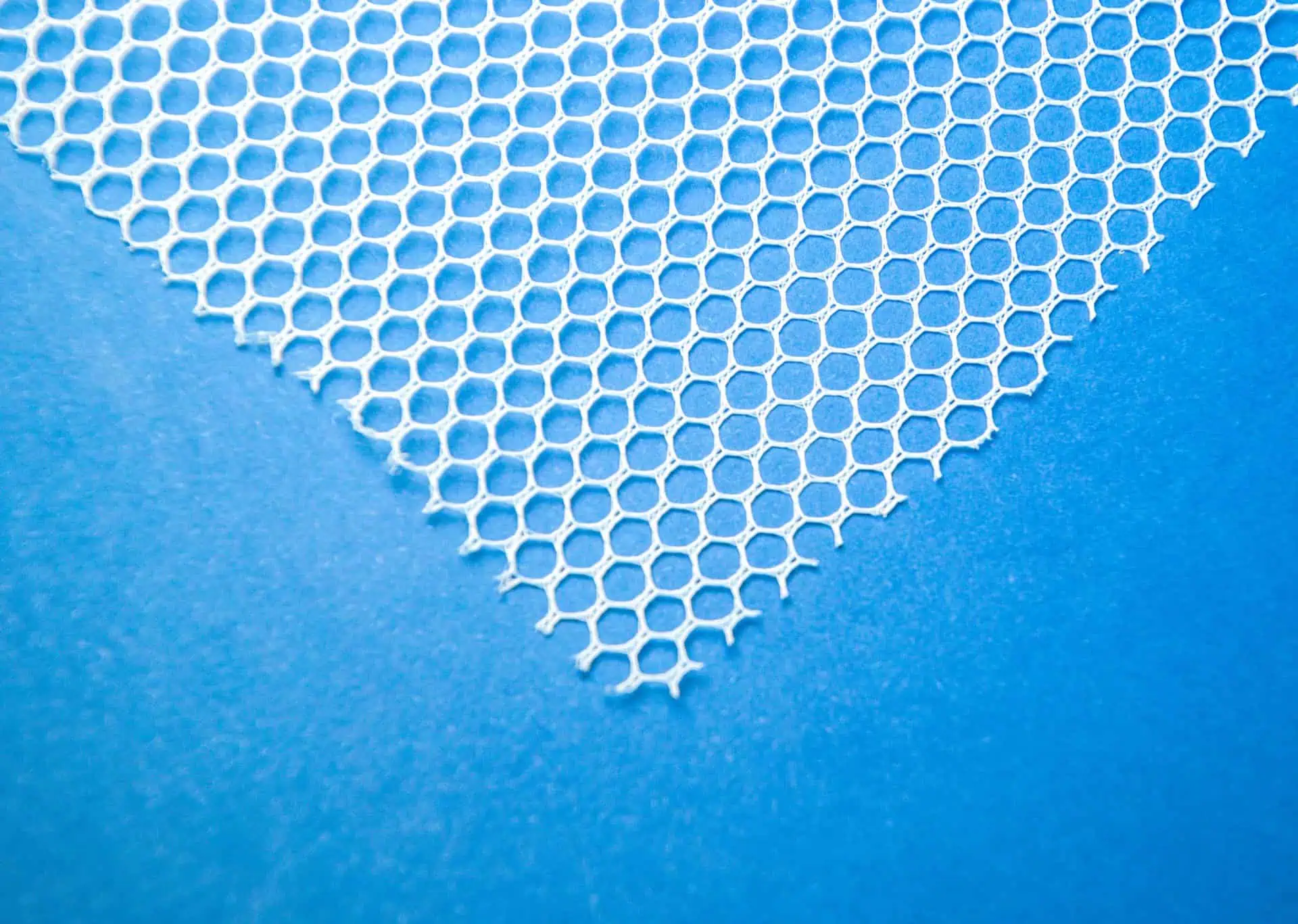What Women Should Know About Transvaginal Mesh
- Last Updated: July 14th, 2025

Attorney Jessica Paluch-Hoerman, founder of TruLaw, has over 28 years of experience as a personal injury and mass tort attorney, and previously worked as an international tax attorney at Deloitte. Jessie collaborates with attorneys nationwide — enabling her to share reliable, up-to-date legal information with our readers.
Legally Reviewed
This article has been written and reviewed for legal accuracy and clarity by the team of writers and legal experts at TruLaw and is as accurate as possible. This content should not be taken as legal advice from an attorney. If you would like to learn more about our owner and experienced injury lawyer, Jessie Paluch, you can do so here.
Fact-Checked
TruLaw does everything possible to make sure the information in this article is up to date and accurate. If you need specific legal advice about your case, contact us by using the chat on the bottom of this page. This article should not be taken as advice from an attorney.
Key takeaways:
- Transvaginal mesh is a treatment used to help with pelvic organ prolapse and stress urinary incontinence. This medical device supports weakened pelvic muscles but has been linked to severe complications.
- The FDA halted sales of transvaginal mesh for treating pelvic organ prolapse in April 2019 due to safety concerns. Women should be aware that while it was once common, its use now has restrictions.
- Different materials are used for transvaginal mesh; some are synthetic, like polypropylene, while others are biological grafts from animal tissue. Decisions on which material to use depend on individual health needs and preferences.
Overview of What Women Should Know About Transvaginal Mesh
On this page, we will discuss an overview of what women should know about transvaginal mesh, transvaginal mesh in female pelvic reconstructive surgery, reoperation for SUI surgery using transvaginal mesh, and much more.
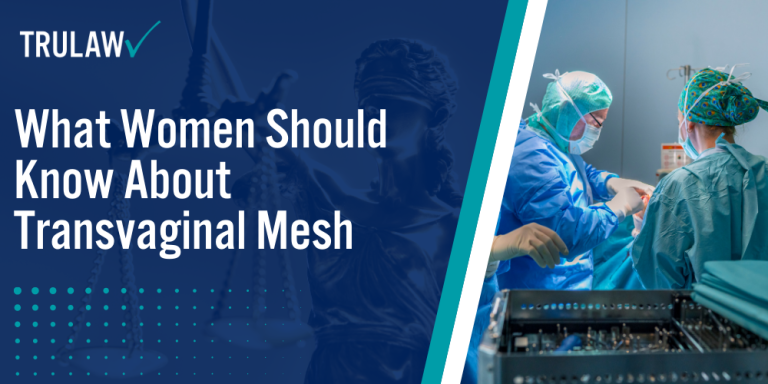
Intro to What Women Should Know About Transvaginal Mesh
Important considerations regarding transvaginal mesh implants include, but are not limited to:
- Assessing Advantages and Disadvantages: Considering the benefits and risks of transvaginal mesh implants is a fundamental step toward making an informed decision.
- Awareness of Complications: Patients considering this treatment option must recognize potential complications such as mesh erosion and pain.
- Legal Rights and Actions: Patients experiencing adverse effects from mesh implants have pursued legal action, resulting in significant settlements.
If you or a loved one have experienced complications from a transvaginal mesh implant, legal recourse may be available.
Contact TruLaw using the chat on this page for a prompt case evaluation to determine eligibility for a transvaginal mesh lawsuit.
Our experienced legal team offers insights into potential compensation, with settlement estimates ranging between $150,000 and $400,000 based on your injuries.
Table of Contents
Transvaginal Mesh in Female Pelvic Reconstructive Surgery
Transvaginal mesh is utilized in female pelvic reconstructive surgery to provide support to weakened pelvic structures.
This medical intervention addresses a range of pelvic floor disorders.
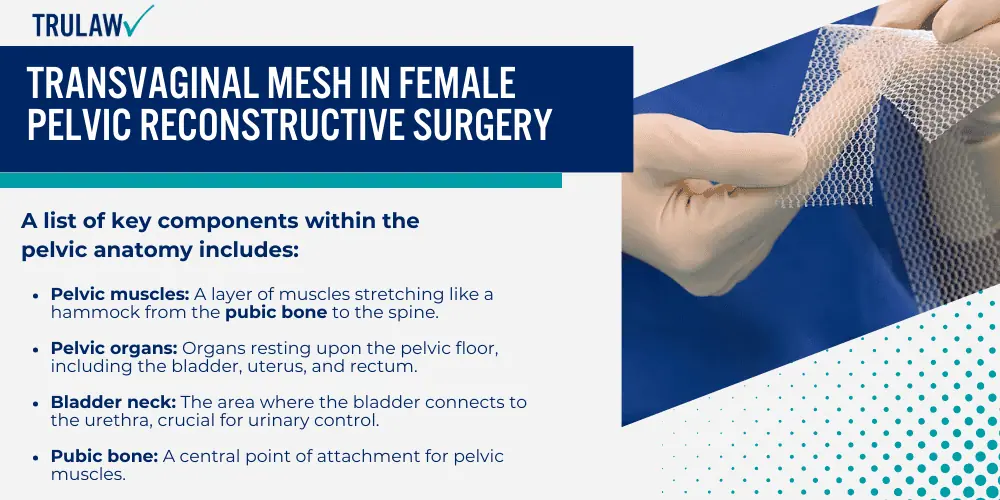
The Pelvic Anatomy
The pelvic region consists of a complex network of muscles, bones, and organs.
Pelvic muscles provide support to the pelvic organs, including the bladder, bowel, and uterus.
The pubic bone at the front and the spine at the back frame the pelvic floor, with the bladder neck positioned at the front of the pelvic region.
A list of key components within the pelvic anatomy includes:
- Pelvic muscles: A layer of muscles stretching like a hammock from the pubic bone to the spine.
- Pelvic organs: Organs resting upon the pelvic floor, including the bladder, uterus, and rectum.
- Bladder neck: The area where the bladder connects to the urethra, crucial for urinary control.
- Pubic bone: A central point of attachment for pelvic muscles.
Common Pelvic Floor Disorders
Pelvic floor disorders encompass a variety of conditions that affect the support and function of the pelvic floor.
Stress urinary incontinence and pelvic organ prolapse are two prominent examples.
Stress urinary incontinence is characterized by the unintentional leakage of urine during physical activity, while pelvic organ prolapse occurs when pelvic organs drop from their normal position into or through the vaginal canal due to weakened support structures.
The common pelvic floor disorders include:
- Pelvic organ prolapse: A downward displacement of the pelvic organs.
- Stress urinary incontinence: Uncontrolled urine leakage prompted by pressure exertion on the bladder.
- Pelvic pain: Discomfort that may be associated with underlying pelvic floor disorder.
- Pelvic floor disorder: Any disorder that affects the integrity and function of the pelvic floor muscles and tissues.
Surgical Treatments and Nonsurgical Treatments for POP
Pelvic Organ Prolapse (POP) is a condition affecting many women, characterized by the descent of pelvic organs into the vaginal canal.
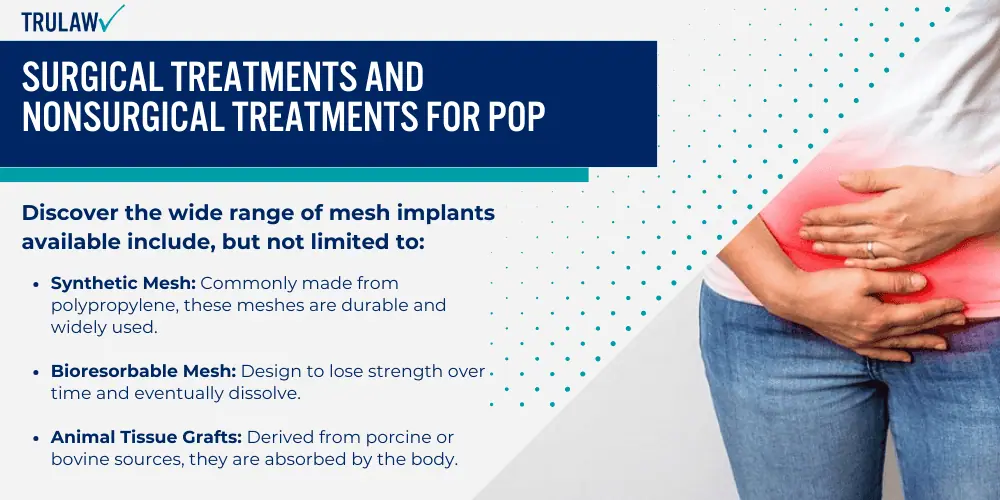
Treatment options range from nonsurgical to various surgical methods, including the use of surgical mesh to provide support.
Mesh Implant Types
The variety of transvaginal mesh implants used in POP treatment includes synthetic polypropylene meshes, bioresorbable synthetic materials, and animal tissue grafts.
Discover the wide range of mesh implants available include, but not limited to:
- Synthetic Mesh: Commonly made from polypropylene, these meshes are durable and widely used.
- Bioresorbable Mesh: Design to lose strength over time and eventually dissolve.
- Animal Tissue Grafts: Derived from porcine or bovine sources, they are absorbed by the body.
- Combined Synthetic and Biological Materials: Some newer meshes combine both types of materials for added benefits.
Surgical Procedure Overview
Surgical repair for POP can be executed via different approaches, each with its own methodologies.
A brief summary of the main surgical options:
- Transvaginal Mesh Surgery: Involves inserting a mesh through the vagina to support pelvic organs.
- Transabdominal Surgical Mesh: The mesh is placed abdominally and provides an alternative to transvaginal placement.
- Native Tissue Repair: Utilizes the patient’s own tissues instead of mesh for pelvic organ support.
- Mesh Sling: A specific type of mesh used to support the urethra and bladder to treat urinary incontinence related to POP.
Comparative Effectiveness
The effectiveness of surgical interventions varies based on methodology and individual patient conditions.
Here’s a comparative overview of the different surgical methods:
- Success Rate: Mesh surgeries generally offer a high success rate compared to non-mesh repairs.
- Complication Risks: Some patients may experience complications associated with mesh, like erosion or infection.
- Recovery Time: Transvaginal mesh procedures typically have a shorter recovery time in comparison to abdominal placements.
- Long-Term Outcomes: A significant percentage of mesh surgeries report long-lasting relief from POP symptoms despite the potential for complications.
Post-Surgical Care
After undergoing surgical procedures for POP, several steps are essential for successful post-surgical care.
Key aspects of post-surgical care include, but are not limited to:
- Activity Restriction: Limiting physical activities to avoid stress on the repair site.
- Pelvic Floor Physical Therapy: Enhancing recovery and strengthening pelvic muscles.
- Follow-up Appointments: Monitoring for potential complications such as mesh erosion or infection.
- Vaginal Cream: Sometimes prescribed to promote healing and maintain tissue health.
Managing Transvaginal Mesh Complications
Effective management of complications arising from vaginal mesh implants involves a multi-faceted approach, including precise diagnosis, appropriate surgical interventions, and an understanding of the evolving legal and regulatory landscape.
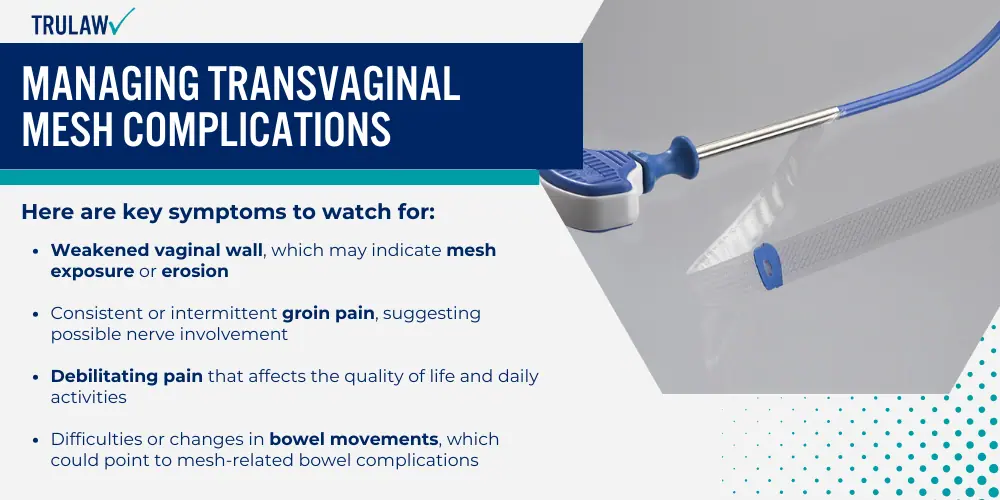
Recognizing Complications
Early recognition of mesh complications is crucial for patient care.
Complications can manifest as groin pain, debilitating pain, or problems with bowel movements.
Here are key symptoms to watch for:
- Weakened vaginal wall, which may indicate mesh exposure or erosion
- Consistent or intermittent groin pain, suggesting possible nerve involvement
- Debilitating pain that affects the quality of life and daily activities
- Difficulties or changes in bowel movements, which could point to mesh-related bowel complications
Removal and Revision Surgeries
When mesh complications become severe, transvaginal mesh removal may be required.
This surgical procedure is delicate and hinges on a few critical steps:
- Detailed assessment of mesh exposure or erosion within the vaginal wall or surrounding tissues
- Careful dissection and removal of the mesh material to alleviate symptoms
- Tailored transvaginal repair of the vaginal wall or affected organs
- Post-operative monitoring and support to minimize the risk of further complications
Legal and Regulatory Surgical Mesh Considerations
Legal and regulatory considerations pertaining to transvaginal mesh have evolved significantly.
Highlighted below are important aspects to keep in mind:
- The FDA regulations have been updated to improve patient safety concerning medical devices like transvaginal mesh.
- Manufacturers face stricter approval processes to ensure efficacy and safety.
- Litigations concerning transvaginal mesh complications have led to increased awareness and compensation for affected individuals.
- Ongoing research and regulation continue to shape the landscape of transvaginal mesh applications and management.
Reoperation for SUI Surgery Using Transvaginal Mesh
Surgical intervention for stress urinary incontinence (SUI) using transvaginal mesh sometimes necessitates reoperation due to complications or recurrent symptoms.
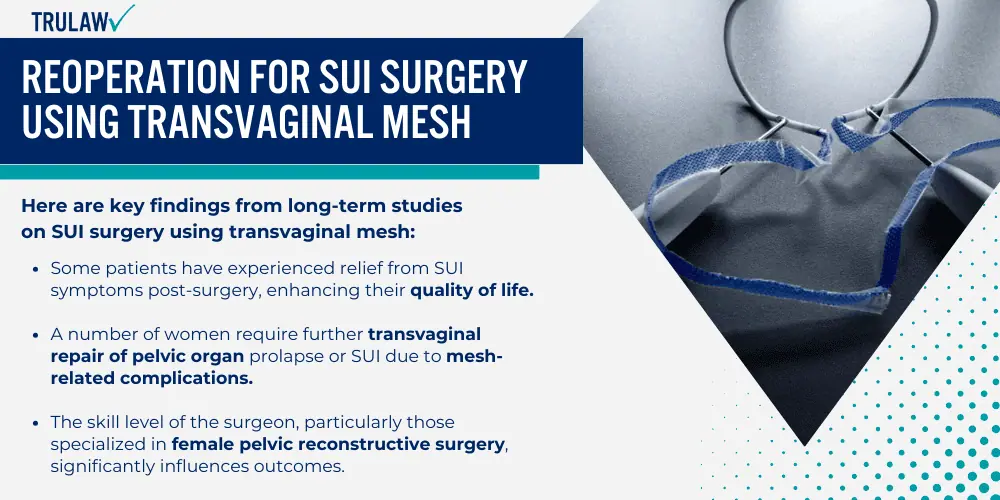
The following discussion outlines the long-term outcomes and the vital support systems available for patients undergoing these procedures.
Long-Term Outcomes
In assessing the long-term outcomes of SUI surgery with transvaginal mesh, studies indicate a mix of successes and challenges.
Reoperation rates are a critical measure of surgical success and patient well-being over time.
Here are key findings from long-term studies on SUI surgery using transvaginal mesh:
- Some patients have experienced relief from SUI symptoms post-surgery, enhancing their quality of life.
- A number of women require further transvaginal repair of pelvic organ prolapse or SUI due to mesh-related complications.
- The skill level of the surgeon, particularly those specialized in female pelvic reconstructive surgery, significantly influences outcomes.
- Various patient support groups report that a subset of patients experiences complications years after the initial procedure.
Support and Advocacy
Support and advocacy play pivotal roles in the journey of patients dealing with transvaginal mesh complications.

These resources provide healthcare advice, emotional backing, and practical information:
- Patient support groups offer a platform for sharing experiences and receiving emotional support.
- Advocacy organizations work towards improving patient care standards and pushing for rigorous long-term studies.
- Educational resources help patients in making informed decisions about female pelvic reconstructive surgery.
- Legal support may be available for those who have experienced significant complications following transvaginal mesh procedures.
FDA Ban on Transvaginal Mesh
In response to safety concerns, the FDA has issued a ban on the sale of transvaginal mesh products for pelvic organ prolapse (POP).
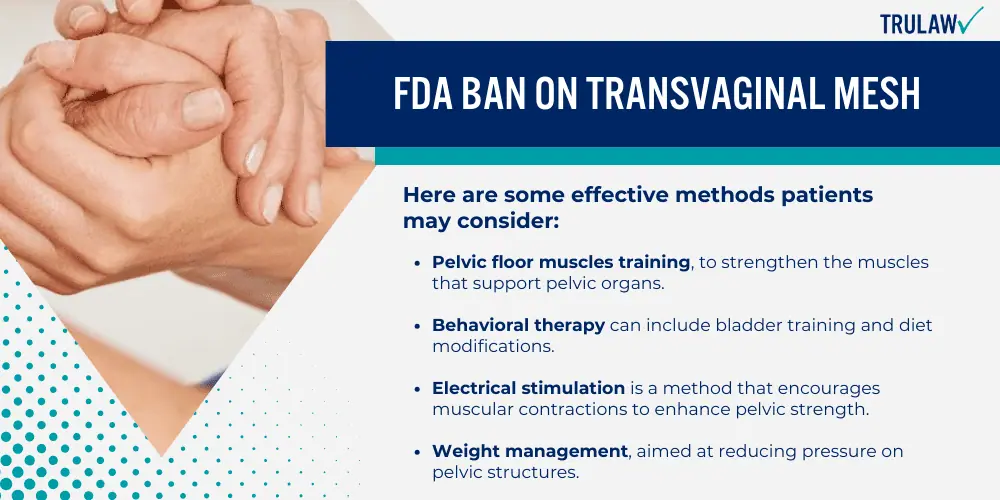
Efficacy and safety concerns have led to increased scrutiny and the eventual removal from the market.
Non-Surgical Options
For those seeking alternatives to surgical intervention for POP, a number of non-surgical treatment options are available.
Here are some effective methods patients may consider:
- Pelvic floor muscles training, to strengthen the muscles that support pelvic organs.
- Behavioral therapy can include bladder training and diet modifications.
- Electrical stimulation is a method that encourages muscular contractions to enhance pelvic strength.
- Weight management, aimed at reducing pressure on pelvic structures.
Emerging Medical Treatments
Research continues to progress in the development of experimental therapies and future medical advancements.
Below are some areas of exploration:
- Biocompatible materials, potentially offering safer alternatives to traditional mesh.
- Stem cell therapy is being studied for regenerative possibilities in pelvic health.
- Custom-fitted pessaries, designed for individual patients without the need for invasive surgery.
- Advanced imaging technologies assist in the precise diagnosis and monitoring of POP and related conditions.
Conclusion
Transvaginal mesh has played a significant role in pelvic reconstructive surgery, with a specific focus on transvaginal prolapse repair and efforts to treat stress incontinence.
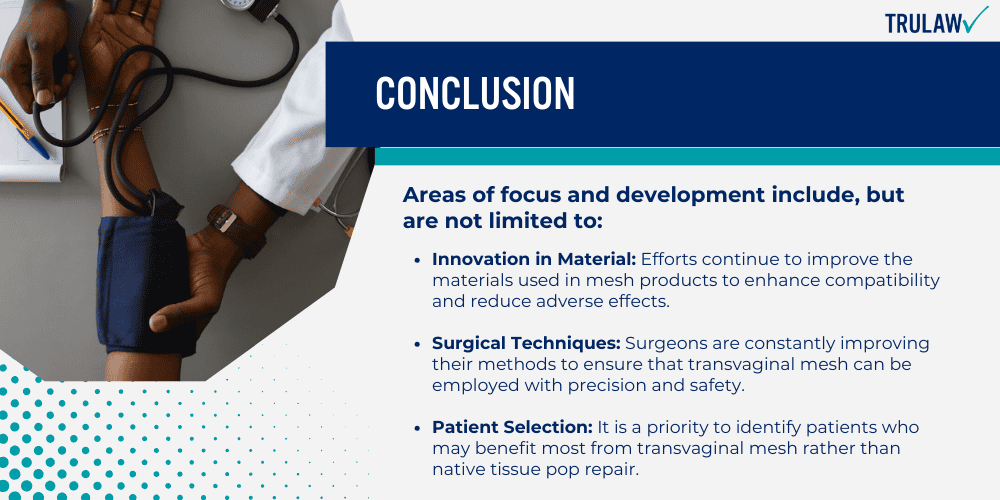
Advancements in this domain aim to address the nuances and complexities involved in treating POP (pelvic organ prolapse).
Future Perspectives
The future of transvaginal mesh in pelvic reconstructive surgery includes multiple facets.
Researchers and clinicians are focusing on reducing complications while preserving the procedure’s benefits.
Areas of focus and development include, but are not limited to:
- Innovation in Material: Efforts continue to improve the materials used in mesh products to enhance compatibility and reduce adverse effects.
- Surgical Techniques: Surgeons are constantly improving their methods to ensure that transvaginal mesh can be employed with precision and safety.
- Patient Selection: It is a priority to identify patients who may benefit most from transvaginal mesh rather than native tissue pop repair.
- Long-Term Outcomes: Studies evaluating the long-term effects of transvaginal mesh on both prolapse repair and stress incontinence contribute to a better understanding of its efficacy.
- Regulatory Scrutiny: Regulatory bodies are closely monitoring mesh-related procedures to ensure patient safety and informed consent.
- Educational Outreach: There is a concerted effort to educate healthcare providers and patients about the risks and benefits associated with transvaginal mesh.
These endeavors collectively aim to safeguard patient health while optimizing the role of transvaginal mesh in treating pelvic organ prolapse and associated conditions.
Transvaginal Mesh Lawsuit Frequently Asked Questions
-
Complications from vaginal mesh surgeries may vary from mild to severe.
Patients often report chronic pain and infection as frequent issues.
Additionally, mesh erosion and urinary problems are notable concerns following the surgery.
-
Several methods can be considered for treating prolapse without mesh.
These include pelvic floor physical therapy, pessary insertion, native tissue repair, or a combination of lifestyle changes and conservative management strategies.
-
Mesh is commonly used in surgeries aimed at correcting pelvic organ prolapse and stress urinary incontinence.
These procedures include sacrocolpopexy for prolapse and mid-urethral mesh slings for incontinence.
Mesh provides structural support where tissue is weakened.
-
Complications from pelvic mesh may manifest through various symptoms.
Individuals might notice persistent pelvic or groin pain, bleeding, painful intercourse, or recurrent urinary tract infections.
These symptoms warrant immediate medical evaluation.
-
A bladder sling procedure specifically aims to treat pelvic floor disorders and stress urinary incontinence by supporting the urethra.
In contrast, the broader term “transvaginal mesh placement” may refer to treatment for both incontinence and pelvic organ prolapse via mesh insertion through the vagina.
-
Surgical mesh is utilized to reinforce the pelvic floor and support weakened tissues.
Its application ranges from addressing pelvic organ prolapse to providing support during bladder sling procedures for stress urinary incontinence.
Mesh acts as a scaffold allowing for tissue integration.

Managing Attorney & Owner
With over 25 years of legal experience, Jessica Paluch-Hoerman is an Illinois lawyer, a CPA, and a mother of three. She spent the first decade of her career working as an international tax attorney at Deloitte.
In 2009, Jessie co-founded her own law firm with her husband – which has scaled to over 30 employees since its conception.
In 2016, Jessie founded TruLaw, which allows her to collaborate with attorneys and legal experts across the United States on a daily basis. This hypervaluable network of experts is what enables her to share the most reliable, accurate, and up-to-date legal information with our readers!
Additional Transvaginal Mesh Lawsuit resources on our website:
Here, at TruLaw, we’re committed to helping victims get the justice they deserve.
Alongside our partner law firms, we have successfully collected over $3 Billion in verdicts and settlements on behalf of injured individuals.
Would you like our help?
At TruLaw, we fiercely combat corporations that endanger individuals’ well-being. If you’ve suffered injuries and believe these well-funded entities should be held accountable, we’re here for you.
With TruLaw, you gain access to successful and seasoned lawyers who maximize your chances of success. Our lawyers invest in you—they do not receive a dime until your lawsuit reaches a successful resolution!
AFFF Lawsuit claims are being filed against manufacturers of aqueous film-forming foam (AFFF), commonly used in firefighting.
Claims allege that companies such as 3M, DuPont, and Tyco Fire Products failed to adequately warn users about the potential dangers of AFFF exposure — including increased risks of various cancers and diseases.
Depo Provera Lawsuit claims are being filed by individuals who allege they developed meningioma (a type of brain tumor) after receiving Depo-Provera birth control injections.
A 2024 study found that women using Depo-Provera for at least 1 year are five times more likely to develop meningioma brain tumors compared to those not using the drug.
Suboxone Tooth Decay Lawsuit claims are being filed against Indivior, the manufacturer of Suboxone, a medication used to treat opioid addiction.
Claims allege that Indivior failed to adequately warn users about the potential dangers of severe tooth decay and dental injuries associated with Suboxone’s sublingual film version.
Social Media Harm Lawsuits are being filed against social media companies for allegedly causing mental health issues in children and teens.
Claims allege that companies like Meta, Google, ByteDance, and Snap designed addictive platforms that led to anxiety, depression, and other mental health issues without adequately warning users or parents.
Transvaginal Mesh Lawsuits are being filed against manufacturers of transvaginal mesh products used to treat pelvic organ prolapse (POP) and stress urinary incontinence (SUI).
Claims allege that companies like Ethicon, C.R. Bard, and Boston Scientific failed to adequately warn about potential dangers — including erosion, pain, and infection.
Bair Hugger Warming Blanket Lawsuits involve claims against 3M — alleging their surgical warming blankets caused severe infections and complications (particularly in hip and knee replacement surgeries).
Plaintiffs claim 3M failed to warn about potential risks — despite knowing about increased risk of deep joint infections since 2011.
Baby Formula NEC Lawsuit claims are being filed against manufacturers of cow’s milk-based baby formula products.
Claims allege that companies like Abbott Laboratories (Similac) and Mead Johnson & Company (Enfamil) failed to warn about the increased risk of necrotizing enterocolitis (NEC) in premature infants.
Here, at TruLaw, we’re committed to helping victims get the justice they deserve.
Alongside our partner law firms, we have successfully collected over $3 Billion in verdicts and settlements on behalf of injured individuals.
Would you like our help?
